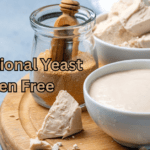Is Nutritional Yeast Gluten Free? The Surprising Truth Revealed!
Apart from flaxseed meals, another substituent that can be included in the diet is nutritional yeast also referred to as brewer’s yeast since it is gluten-free and hence useful to clients suffering from celiac disease. However, one has to be very careful during processing since it is easily contaminated, and it is better to use specially marked gluten-free brands. In regards to nutrition, it has enormous merits, it is very rich in protein and B vitamins and is often used to emulate cheese by those who are vegan or lactose intolerant.
This is an easily variable product that can act as a seasoning for different foods. When selecting products with multi-grain or whole-grain labels, do not go for the ones that are just labeled ‘gluten-free,’ or those with the stereotype ‘Gluten-Free. ’
Introduction to Nutritional Yeast
Nonetheless, nutritional yeast is gradually gaining acceptance by people with a sensitive diet, vegetarians, and even food enthusiasts with gluten intolerance. But one common question remains: What about using nutritional yeast, Does this product contain gluten? In this particular article, we will therefore look at Nutritional yeast, whether or not it contains gluten, and the application of this product.
What is Nutritional Yeast?
Nutritional yeast or nooch is a type of yeast that can be consumed since it is deactivated yeast that is grown on molasses, or sugarcane. The taste of this product is described as nutty and cheesy and therefore recommended for use in the preparation of different vegan and no dairy products meals. Nutritional yeast is a kind of yeast that doesn’t have the features of baking yeast that makes dough ferment and rise, it doesn’t cause the dough to rise. Rather, it is taken for the sake of taste and quality nutrients that it is supposed to bring into the body system.
Nutritional Yeast vs. Brewer’s and Baker’s Yeast
Differences between Nutritional Yeast, Brewer’s yeast, and baker;s yeast An overview To be able to fully understand the function of dietary yeasts in your food choices or nutrition plan you first need a better understanding of differences for example nutritional vs brewer’s barm /yeast.
- Nutritional Yeast: Nutritional Yeast- Inactive yeast is often used for flavor enhancement as well as adding very high levels of protein and vitamins to a vegan diet. It is a rich source of B Vitamins and is usually fortified with B12, which is why it remains popular among vegans.
- Brewers Yeast: A beer by-product that is often used as a nutritional supplement. Like nutritional yeast, it tastes more bitter and can be gluten-y if not all brewers are brew-gluten-free.
- Baker’s yeast: Baker’s yeast is used in baking and bread-rising. Whereas nutritional yeast is non-alive or active.

An Insight on Gluten — What it is and Where to Find It
Gluten — A protein found in wheat, barley, and rye. It produces the stretchy and elastic structure of the dough, as well as supports in making bread rise. Gluten, however, tends to be harsh on the digestive system for those with celiac disease or even gluten sensitivity; so not even a trace amount should be consumed.
Allergic Reactions to Nutritional Yeast 2.1 Is Nutritional Yeast Gluten-Free Naturally?
Nutritional yeast is naturally gluten-free. However, it is derived from molasses or sugarcane which means there are no gluten proteins present by nature. But the danger is that this can cross-contaminated during processing or packaging, and thus transmit gluten into what you eat.
Production of Nutritional Yeast
Nutritionally, yeast is made by growing yeast cultures on a sugar-rich medium like sugarcane or beet molasses. After the yeast is fully grown, it gets killed off with heat to stop this process and then washed out and dried into flakes or powders. The process is carefully regulated to maintain the yeast in a pure form.
Gluten-Free: Concerning Cross-Contamination
Cross-contamination when gluten-free products are touched by gluten ingredients. This, of course, would be at different stages:
- Production Facilities: But if the same equipment is also used for processing gluten-containing products, there’s a risk even of cross-contamination.
- Packaging Lines: Packaging Lines – This can be a source of contamination via shared packaging lines when proper cleaning protocols are not followed.
- Condition of storage: proximity and possible contamination from gluten-free or gluten-containing products.
How to Identify Gluten-Free Nutritional Yeast
Nutritional yeast is a popular ingredient among vegetarians who crave cheese, but unfortunately, most varieties contain gluten That’s why people who need to adhere to a gluten-free diet often wonder how to identify gluten-free nutritional yeast.
It is important to note that not all nutritional yeast is free from gluten and therefore one has to be very keen when choosing nutritional yeast. Here are some tips:

Reading Labels
- Also, check for a gluten-free label or a… This means that in many countries, this evidences that the product contains below 20 Parts per Million PPM of gluten, a benchmark provided by the respective regulatory bodies.
- Make sure there are no ‘gluten-inducing grains such as wheat, barley, or rye on the list of contents. ’
- Be careful of allergen statements that may suggest cross-contamination with gluten-containing products.
Trusted Brands
Some of the best nutritional yeast brands are particularly famous for offering gluten-free products. These brands often undergo third-party testing to verify the absence of gluten: These brands often undergo third-party testing to verify the absence of gluten:
- Bragg Nutritional Yeast: It is among those brands of products well known for its Gluten-Free logo.
- Bob’s Red Mill Nutritional Yeast: One of the most selected options that does not allow gluten to cross-contact with foods.
- Red Star Nutritional Yeast: All the products contain gluten-free options, they even label it for the benefit of customers.
Benefits of Nutritional Yeast
Nutritional yeast is not just a gluten-free flavor enhancer; it’s also packed with nutritional benefits that can boost your diet: Nutritional yeast is not just a gluten-free flavor enhancer; it’s also packed with nutritional benefits that can boost your diet:
High in Protein
nutritional yeast – complete protein food containing 9 vital amino acids required for proper body functioning. It contains up to 9 grams of protein in only two tablespoons making it a great supplement for vegetarians and vegans.
Rich in B Vitamins
Since nutritional yeast is most often derived from the Saccharomyces cerevisiae fungus, this product is especially rich in B-group vitamins. Often it is mixed with B12, the vitamin that helps the nerves work and helps the body make red blood cells. It makes it so valuable to the vegan, who may find it very hard to get the B12 vitamin in his or her diet naturally.
Contains Antioxidants
Besides, nutritional yeast includes such antioxidants as glutathione and selenomethionine that work surprisingly effectively in combating free radicals. These antioxidants help in general well-being and possibly have benefits in preventing chronic diseases down the road.
How to Use Nutritional Yeast in Cooking
There are following ways which will show how to use nutritional yeast in cooking:
As a Cheese Substitute
Because of the flavor, nutritional yeast favor resembles cheese and thus can be an ideal substitute for cheese Use it as a topping to popcorn, pasta, or pizza to give it a taste resembling Parmesan cheese.
In Soups and Sauces
Readily available in health food stores, the flakes can be sprinkled over soups, sauces, popcorn, and salads and even used as a seasoning for meats. Best used when making vegan cheese sauce, making soups thicker, or thickening gravies.
As a Seasoning
Nutritional yeast is great as a flavor enhancer and can be sprinkled over roasted vegetables, tofu, or even salads. From the taste point of view, it gives an incredible savory addition to many recipes making the food tasty.
What We Need to Know about the Possible Adverse Effects of Nutritional Yeast
While nutritional yeast is generally considered safe for most people, there are a few potential side effects to be aware of:
- Allergic Reactions: Some may be sensitive to yeast or some of its by-products which may cause a rash on the skin, itching, or stomach upset among others.
- Migraines: Nutritional yeast contains tyramine which has been said to cause migraines in people who are most sensitive to this substance.
- Digestive Issues: At high intake, nutritional yeast may lead to bloating or gas, or other gastrointestinal issues attributed to its fiber-rich nature.
The use of Nutritional Yeast in Vegan and Vegetarian Diets
Nutritional yeast belongs to the list of useful products that every vegan or vegetarian should include in their daily diet. It is rich in B vitamins and protein and therefore can be applied in plant-based diets because of its high protein level. It offers nutrients that may not be availed when taking plant-based foods that are rich in vitamins minerals and proteins.

Can Celiacs Consume Nutritional Yeast?
You can eat nutritional yeast if you have celiac disease but make sure the yeast is gluten-free certified. People with celiac disease cannot take foods that contain even a small portion of gluten and therefore should choose brands with gluten-free certifications and those that can explain the steps they follow when preparing the products.
Gluten-Free Certifications: That is what you should look for
When shopping for gluten-free nutritional yeast, look for certifications from trusted organizations, such as: When choosing gluten-free nutritional yeast always consider checking for certification from reliable bodies such as;
- The Gluten-Free Certification Organization (GFCO): The ‘gluten-free certification’ we see indicates that foods cannot have more than 10 milligrams of this protein per liter.
- Celiac Support Association (CSA): The ‘Gluten-Free’ mark does mean, the amount of Gluten used in the product does not exceed 5 ppm.
- FDA Gluten-Free Labeling: All products with gluten-free labels approved by the FDA should have a gluten level that does not exceed 20 ppm.
Conclusion
Nutritional yeast can be recommended as a wonderful and quite health-beneficial ingredient one should use when cooking foods with Gluten a diet. Since these foods do not contain gluten by default there is always a possibility of cross-contamination hence individuals suffering from gluten sensitivity or celiac diseases should be wary of their chosen brands. If one searches for gluten-free certifications and if one is particular about the labels, then it is easy to enjoy the aspects of this yeast adjunct while avoiding gluten completely.
FAQs about Is Nutritional Yeast Gluten Free
Can I use nutritional yeast if I have a Gluten intolerance?
Nutritional yeast is safe for those who have gluten intolerance provided that vitamin yeast is certified gluten-free and that during the processing of the food, there is no cross-contamination with glutinous products.
Can nutritional yeast be cross-contaminated with gluten?
Nutritional yeast is particularly a non-brewed yeast, which is inherently free from gluten; however, it could contain gluten through cross-contact during processing and packaging. Selecting brands with certified gluten-free is one way of reducing such a possibility.
Gluten is a protein in wheat, barley, and rye cereal grains and when choosing products to eat, what should I check on the labels?
When shopping for gluten-free foods, it is important to check if the manufacturer places ‘gluten-free’ somewhere on the package, to avoid if there are any signs of gluten ingredients, and to read extra statements that suggest that other gluten items were processed in the same facility.
What are the possible drawbacks to eating nutritional yeast?
It may cause an allergic reaction or give people who are sensitive to migraines a splitting headache and if taken in large doses it is said to upset the digestive system.
What makes nutritional yeast different from other yeasts on the market?
Nutritional yeast is used for taste and nutritional purposes and it is inactive; brewer’s yeast is produced as a byproduct of beer making; baker’s yeast is active and it is used in baking to make dough rise.
My Opinion about Is Nutritional Yeast Gluten Free
Nutritional yeast is quite amazing and one thing I don’t mind adding to my diet especially when one is Gluten sensitive or vegan. This together with its cheesy umami taste is a real game-changer in plant-based cooking where it is used to boost the taste of a dish without the need to use cheese or wheat. They are lean and loaded with nutrients like the B group vitamins as well as proteins which makes them not only a tastemaker but indeed a booster.
However, similarly to other diet products, one should use only products that are recognized worldwide and it is necessary to read the labels to determine if the product contains any ingredients that may be a cross contamination.
Disclaimer about Is Nutritional Yeast Gluten Free
The reader needs to note that all the information given in this article should not be taken as advice from a medical practitioner. It is always advisable to seek the advice of a doctor especially if you have celiac disease, gluten issue, or any other type of dietary problem before you attempt any change in the type of food that you take. In this case, we take all reasonable measures to make the information as accurate as possible but we will not accept any liability for any loss or damage that may arise from using the information provided here.
It is for this reason that one should always have to read labels and engage the manufacturing companies for the most recent information regarding gluten.







